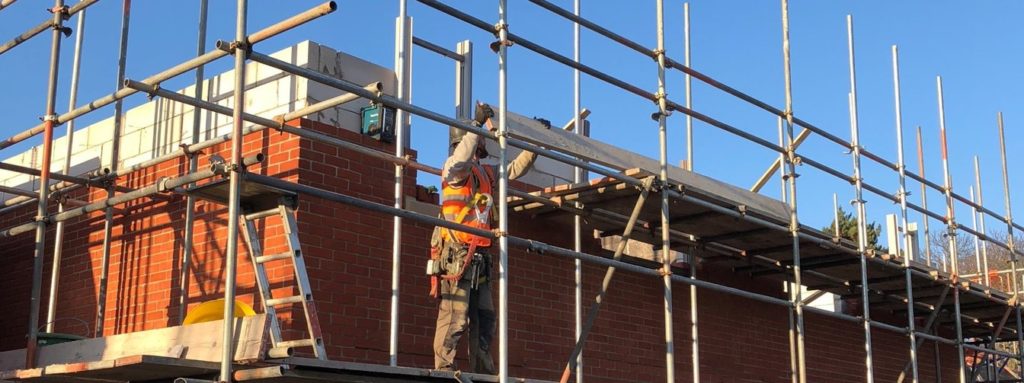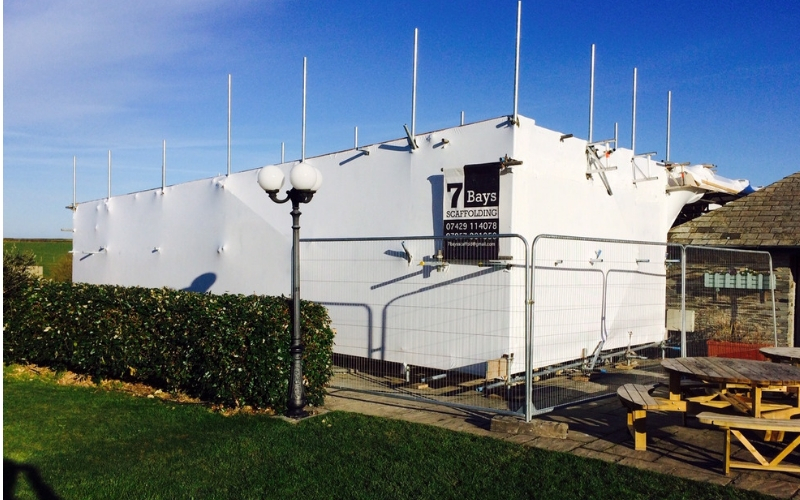The cold, wet, windy winter season is upon us, bringing with it its own set of challenges and considerations, especially for those working in construction. The Cornish weather can pose significant risks, particularly to the scaffolding structures used in construction sites, so understanding scaffolding safety is even more important at this time of year.
Scaffolding is a crucial component in the construction industry, providing support, access, and safety for construction workers to carry out their job effectively. However, in winter conditions, the challenges multiply, making it essential to understand the measures necessary to ensure safety and functionality.
How to Weather-Proof Your Site
- Ice and Snow Accumulation: One of the primary concerns during winter is the accumulation of ice and snow on scaffolding structures. This buildup can add weight, impacting the scaffolding’s stability and potentially causing structural integrity issues.
- Slippery Surfaces: Icy or wet surfaces are a hazard for workers accessing scaffolding. It increases the risk of slips, trips, and falls, leading to severe injuries or fatalities if not addressed promptly.
- Temperature Extremes: The extreme cold can affect the materials used in scaffolding, causing them to become brittle or less resistant, compromising their strength and stability.
The Importance of Winter Scaffolding Maintenance
Routine inspections become even more critical in winter. Checking for ice buildup, ensuring proper drainage to prevent water accumulation, and examining the integrity of materials are essential steps which should be undertaken to ensure that your scaffolding is as safe and secure as can be. Get in touch if you are concerned about your scaffolding safety and ask us to carry out a safety check if you’re in doubt.
- De-icing and Snow Removal Timely removal of ice and snow from scaffolding prevents excess weight and maintains structural stability. Using appropriate de-icing methods without damaging the scaffolding components is crucial.
- Anti-Slip Measures Installing anti-slip materials or coatings on platforms and walkways can significantly reduce the risk of accidents due to slippery surfaces.
Safety Measures for Winter Scaffolding Work
- Training and Awareness: Educating workers about winter-specific safety protocols, recognising hazards, and proper usage of personal protective equipment (PPE) in cold conditions is vital. Ensure that your workers are protected against the weather, and that your construction site is weather-proofed as best as it can be. Sometimes building and refurbishment projects require a temporary roof to keep everything protected from the weather.
- Temporary Roofing This can be crucial for the renovation of buildings; they protect from weathering and stop the building’s structural design being weakened. Sometimes we fit temporary roofs as a means of controlling the environment – where specific temperature or humidity control is required for instance. Installing a temporary roof also helps to protect your workers from rain, snow and wind chill which in turn ensures that work can continue in all weather conditions. Temporary roofs help you to complete your construction projects on time, no matter what the weather.
- Temporary Roof Encapsulation We use the latest, most efficient shrink-wrapping technology when installing sides to completely weather-proof your construction project and enclose the temporary roofing structure. Shrink-wrap is the most reliable method of containment and we find that it protects most effectively against side winds and strong weather conditions. The shrink-wrapped design allows natural light to enter the site so that it remains a safe working environment for your team, and it is also 100% recyclable which makes it environmentally friendly. Shrink-wrapping is versatile, lightweight and gives a drum-tight finish which looks professional and smart.
- Weather Monitoring Keeping an eye on weather forecasts helps anticipate and prepare for adverse conditions, allowing for proactive measures to safeguard scaffolding.
- Communication Open communication channels among workers, supervisors, and management ensure everyone is informed about safety procedures and any concerns regarding scaffolding in winter.
Scaffolding is the backbone of construction, and its safety and maintenance during winter are paramount. The challenges posed by winter weather demand proactive measures, vigilance, and a commitment to safety protocols to mitigate risks effectively.
By understanding the unique challenges winter brings, conducting regular maintenance, implementing safety measures, and fostering a culture of awareness and preparation, the construction industry can navigate the winter season with resilience, ensuring the safety of its workers and the integrity of its structures. We can create bespoke temporary roofs for buildings and structures of any shape, size and dimension to ensure a safe fit for all scaffolders tradesmen who will be working on the structure.
In embracing these practices, we not only prioritise the wellbeing of those working in construction but also uphold the standards of safety and excellence in an ever-evolving environment.
Don’t leave the weather to damage your roof or construction project this winter! Call our team of highly skilled scaffolders and we can discuss your temporary roofing requirements. We focus on customer satisfaction and delivering the best service possible and would love to offer you advice on weather-proofing your project. Get in touch today for a free quote, we can’t wait to assist you!



